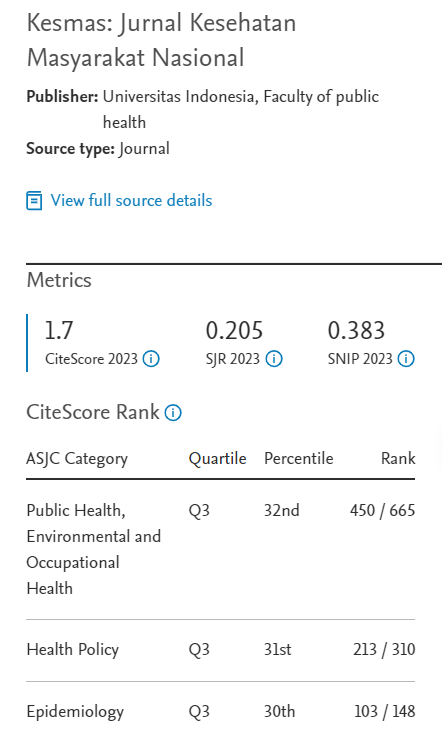Abstract
Data tentang faktor-faktor yang berhubungan dengan sindrom metabolik pada kelompok eksekutif di Indonesia yang diperlukan untuk upaya pencegahan penyakit kardiovaskular sangat terbatas. Penelitian ini bertujuan untuk mengetahui prevalensi dan determinan sindrom metabolik pada kelompok eksekutif. Penelitian dilakukan di Jakarta dan sekitarnya dengan menggunakan rancangan cross sectional. Jumlah responden yaitu 220 orang eksekutif laki-laki dan 68 orang eksekutif wanita. Pengumpulan data dilakukan dengan pengukuran antropometri, analisis biokimia darah, analisis asupan makanan, pengukuran angka stres, dan pengukuran indeks aktivitas. Analisis regresi logistik ganda dilakukan untuk mengetahui hubungan beberapa independen variabel dengan dependen variabel. Analisis ini menghasilkan indeks massa tubuh (overweight, odds ratio (OR) = 5,54; obesitas, OR = 7,44) dan rasio total kolesterol/high density lipoprotein (HDL)-kolesterol (OR = 8,83) sebagai determinan sindrom metabolik pada kelompok eksekutif. Penelitian ini menunjukkan bahwa pemeriksaan profil lipid dan pengukuran antropometri sederhana yang teratur pada kelompok eksekutif penting dilakukan untuk mendeteksi risiko sindrom metabolik.
Available datas on metabolic syndrome among Indonesian executives are limited, despite the fact of the importance of these data for cardiovaskular prevention. The objective of this study was to assess prevalence of metabolic syndrome and its associations between anthropometric measures, lipid profiles, blood pressure, nutrient intakes, and life style in executive group. A cross sectional study was undertaken in some factories in Jakarta, using multistage random sampling. The respondents were 287 executives, 219 male and 68 female. Data were collected through anthropometric measurements, biochemical blood analysis, nutrient intake, stress score, and activity index assessment. Multiple logistic regression analysis used to assess associations between independent variables and metabolic syndrome. This study showed that body mass index (overweight, odds ratio (OR) = 5,54; obesity, OR = 7,44) and ratio serum total cholesterol to high density lipoprotein (HDL)-cholesterol (OR = 8,83) were potential determinants of metabolic syndrome. This study shows the importance of routine check of lipid profile, blood pressure, and simple anthropometric assessment to detect the risk of metabolic syndrome in the elderly.
References
- Boedhi DR. Penelitian penyakit kardiovaskular di masyarakat pedesaan. Medika. 1996; 6: 450-7.
- Ford ES, Giles. Prevalence of metabolic syndrome among US adults: findings from the third national health and nutrition examination survey. JAMA. 2002; 287 (3): 356-9.
- Kamso S. Metabolic syndrome in the Indonesian elderly. Medical Journal of Indonesia. 2007; 16 (3).
- National Cholesterol Education Program criteria modified for Asians (NCEP ATP III) Expert Panel on Detection, Evaluation, and Treatment of High Blood Cholesterol in Adults. Executive Summary of the Third Report of the National Cholesterol Education Program (NCEP) Expert Panel on Detection, Evaluation, and Treatment of High Blood Cholesterol in Adults (Adult Treatment Panel III). JAMA. 2001; 285: 2486-97.
- Guo S. Aging, body composition, and life style: the fels longitudinal study. American Journal of Clinical Nutrition. 1999; 70 (3): 405-11.
- Turcato. Waist circumference and abdominal sagittal diameter as surrogates of body fat distribution in the elderly: their relation with cardiovascular risk factors. International Journal of Obesity. 2000; 24: 1005-10.
- Kathryn. Abdominal adiposity and coronary heart disease in women. JAMA. 1998; 280: 1843-8.
- Marmot MG. Epidemiology of tryglicerides and coronary heart disease. Lancet. 1995; 342: 781-2.
- Tsigos C. Hypothalamic pituitary adrenal axis, neuroendocrine factors, and stress. J. Psychosom Res. 2002; 53 (4): 865-71.
- Lara-Castro C, Fu Y, Chung BH, Garvey WT. Adiponectin and the metabolic syndrome: mechanisms mediating risk for metabolic and cardiovascular disease. Curr. Opin. Lipidol. 2007; 18 (3): 263-70.
- Carr MC. Abdominal obesity and dyslipidemia in the metabolic syndrome: importance of type 2 diabetes and familial combined hyperlipidemia in coronary artery disease risk. J. Clin. Endocrinol. Metab. 2004; 89 (6): 2601-7.
- Huang. Obesity in the elderly and its relationship with cardiovascular risk factors in Taiwan. Obesity. 2005;13 (1): 170-8.
- Shen. Waist circumference correlates with metabolic syndrome indicators better than percentage fat. Obesity. 2006; 14 (4): 727-36.
- Kannel WB. Risk stratification in hypertension: new insights from the framingham study. Am J Hypertens. 2000; 13: 3S-8S.
- Katzmaryk. Targeting the metabolic syndrome with exercise: evidence from the heritage family study. Med. Sci. Sports Exerc. 2003; 35 (10): 1703-9.
- Rennie KL. Association of the metabolic syndrome with both vigorous and moderate physical activity. International Journal of Epidemiology. 2003; 32: 600-6.
- Susan EB. Physical activity and the metabolic syndrome in Canada. Appl. Physiol. Nutr. Metab. 2006; 31: 40-7.
- Andrea RJ. Nutritional determinants of metabolic syndrome. J. Nutrigenet Nutrigenomics. 2008; 1: 109-17.
- Magdalena SR, Mai-Lis BH, De Faire UH, Gunnar KJ. Associations between diet and the metabolic syndrome vary with the validity of dietary intake data. American Journal of Clinical Nutrition. 2003; 78 (1): 84-90.
- Jee YO, Young SH, Yeon AS, Elizabeth BC. Prevalence and factor analysis of metabolic syndrome in an urban Korean population. Diabetes Care. 2004; 27: 2027-32.
- Siani A, Cappuccio FP, Barba G, Trevisan M, Farinaro E, Lacone R, et al. The relationship of waist circumference to blood pressure: the olivetti heart study. Am J Hypertens. 2002;15 (9): 780-6.
- Kannel WB. Fifty years of framingham study contribution to understanding hypertension. J Hum Hypertens. 2000;14: 83-90.
- Kannel WB. Risk stratification in hypertension: new insights from the framingham study. Am J Hypertens. 2000; 13: 3S-8S.
- Weverling R, Blauw GJ, Lagaay AM, Knook DL, Meinders AE, Westendorp RGJ. Total cholesterol and risk of mortality in the oldest old. N. Engl. J. Med. 1997; 350: 1119-23.
- Philip TJ. The obesity epidemic, metabolic syndrome, and future prevention strategies. European Journal of Cardiovascular Prevention and Rehabilitation. 2004.
Recommended Citation
Kamso S , Purwantyastuti P , Lubis DU ,
et al.
Prevalensi dan Determinan Sindrom Metabolik pada Kelompok Eksekutif di Jakarta dan Sekitarnya.
Kesmas.
2011;
6(2):
-
DOI: 10.21109/kesmas.v6i2.110
Available at:
https://scholarhub.ui.ac.id/kesmas/vol6/iss2/5







